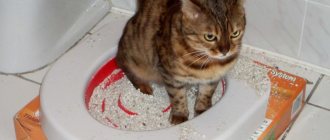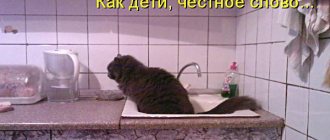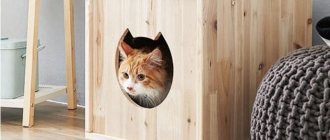How to train a cat to use the toilet after using the litter box?
If the owner wants his cat to go not to the tray, but to the toilet, this is not a whim at all. This method of providing animals with their natural needs has a number of advantages:
- There will be no cat litter box in the house. For many, placing this element of a pet dowry is difficult, especially if the home is small. Firstly, cats like to go to the toilet in a secluded place; a corner is needed for the litter box. Secondly, cats do not go to the toilet where they eat. Thirdly, sometimes a cat potty spoils the aesthetics of the room. One cannot but agree that it is much more convenient if the animal goes to the toilet.
- There will be no need to waste time and money on buying litter for the tray. Despite the fact that the filler is relatively inexpensive (depending on the type, of course), you usually need a lot of it, and a lot of money goes out of the family budget. Cat on the toilet - savings for the family.
- If a cat relieves itself on the toilet, the house will not smell of its discharge, and there will be no traces of wet paws on the floor. Of course, provided that they immediately clean up after the fluffy one. But even if the cat’s “business” goes unnoticed for some time, the toilet is an isolated room with good ventilation.
If a cat goes to the toilet, it is convenient, economical and hygienic.
IMPORTANT: Only an adult healthy cat who uses a litter tray can be toilet trained. A small kitten may fall into the bowl of a plumbing fixture, choke or get injured. You need to wait until he grows up. An old cat with sore joints or an overweight animal is unlikely to jump on the toilet and, most likely, will make puddles and piles on the rug next to it. These nuances must be taken into account.
How to train a cat to use the litter box so that later it can go to the toilet is written in this article: link
They say that animals, like people, develop a habit within three weeks. Of course, all cats are individual, and some especially lazy ones need much more time to toilet train, up to 2 months. But experienced cat owners say that absolutely everyone can be taught to go to the toilet.
Preparing to teach an animal to relieve itself in the toilet consists of three stages and requires certain preparation from the owners:
- It is necessary to prepare the bathroom, remove everything unnecessary from there, and free up space near the toilet where the cat's potty will be temporarily located. If we are talking about a private house or a large apartment with several bathrooms, choose the one that is more accessible for the cat, for example, on the ground floor.
- You will also need some equipment: a potty that the cat usually goes into, a training tray (discussed below), litter that can be flushed down the drain, cardboard boxes or old newspapers that will lift the tray.
- Learn to keep the bathroom door open so that the cat can come in at any time.
- Learn to keep the toilet lid open. Guests at home will always have to be warned about this. If the owners have the habit of lowering the lid, they themselves will have to relearn. You need to remember: if the cat is accustomed to the toilet, its closed lid equals a puddle or pile in the corner.
- Stock up on detergents, because now you will have to wash and clean the toilet more often.
IMPORTANT: If you can’t buy a convenient training kit for training your pet to go on the toilet, you can make it yourself, or even do without it.
Only adult healthy cats who regularly use the litter box are trained to use the toilet.
When the bathroom is ready, the cat's litter box is moved into it. It is better to do this gradually, moving the tray closer and closer to the toilet so that the cat does not get confused and start “walking” anywhere. Afterwards the actual training begins:
- The first stage takes approximately two weeks. The tray is placed near the toilet. Cardboard or newspapers are placed under it. Every day they raise the tray higher and higher, so that eventually it is level with the toilet. The cat will get used to the fact that he will need to jump onto the tray, and then he will easily climb onto the toilet.
- If there is no special tray, a regular one with low sides is placed on the toilet lid. Leave it in this position for two days so that the cat gets used to jumping on the toilet every time he wants to go to the toilet.
- Remove the potty from the toilet. They monitor the animal’s behavior for several days, identifying whether it has developed the habit the owners need.
Stages of toilet training a cat.
IMPORTANT: If, when training a cat to go to the toilet on the toilet, he commits sins a couple of times, under no circumstances should you scold him for this. Such a way of relieving himself is unnatural for him, contrary to his instincts. The animal is under stress, you need to be patient and consistent.
Toilet training a cat: stage 1.
Toilet training a cat: stage 2.
If toilet training ends in failure, do not despair. Each cat has its own individual characteristics. They don't like confined spaces.
Others are shy, they instinctively bury their feces, and the option without litter is not for them. Still others find it uncomfortable to sit on the toilet lid because of their size, etc. When you get a pet, you need to think not only about your desires, but also about its comfort.
Moreover, now you can choose the trays for cats that you want, this article will help you choose the most convenient one: link
Useful tips
And now the result has been achieved. Your pet successfully does its business on the toilet. Now you need to follow two rules:
- Keep the toilet door ajar at all times so that the cat can easily get in at any time. In some cases, you can cut a special cat hole in the door.
- Never lower the toilet lid. Your pet should always have the opportunity to go to the toilet when he needs it.
You should always praise your pet for correct actions. Cats understand affectionate and encouraging intonations very well.
Toilet training system for cats. Set, simulator for accustoming a cat to the toilet
For the convenience of owners and animals, manufacturers of products for cats produce special systems for training cats to use the toilet on the toilet.
Their configurations may vary, but the principle remains the same: a device similar to an ordinary cat potty is gradually modified, turning into something similar to a toilet seat.
The most popular training systems due to their convenience are:
- Domakot
- Unicott
- Litter Kwitter
- CitiKitty Cat Toilet Training Kit
- VACA
Systems for toilet training a cat.
IMPORTANT: Such simulators cost a decent amount, 600 to 4000 rubles depending on the manufacturer.
Toilet training with the Litter Kwitter system.
Toilet training using this system in the early stages differs little from the one described above.
- A training tray with a solid bottom is filled with litter that the cat usually uses. The tray is placed near the toilet.
- Gradually raise the tray, leveling it in height with the toilet lid over the course of two weeks. At the same time, the filler is gradually changed to one that can be flushed down the toilet.
- Install the training system directly on the toilet. It still looks like a regular tray. When the cat confidently jumps on the toilet and goes to the potty, you need to replace the solid tray with a tray with a hole, if it is a Litter Kwitter system, go cut off the smallest ring in the center of the tray, if it is Domakot.
- After a couple of days, enlarge the hole in the center of the pan or replace the pan. Accordingly, pour less filler into the tray.
- Gradually increase the diameter of the hole in the tray to the diameter of the toilet bowl. Then you can remove the training tray completely. As a rule, training on the system after installing it on the toilet takes 10-14 days.
Toilet training with the DOMAKOT system.
The simplest simulator for training a cat to use the toilet is a plastic attachment with a small hole. It is installed on top of the bowl of the sanitary ware.
A simple simulator for training a cat to use the toilet.
The advantage of this type of design is that it is very ergonomic, so a small cat can use the toilet.
Training a one-month-old kitten
A one-month-old baby should be with its mother. During this period, he strengthens his immunity with the help of milk, and also receives social skills from an adult cat and brothers and sisters. It is the mother cat who usually shows her children how to go to the toilet correctly. But sometimes such babies are left alone, and a person has to partially take on the role of mother.
The baby is still very poorly oriented in space and does not always walk confidently, so his place of residence should be limited. In a small space you should place the necessary items:
- Bed;
- Bowls for food and water;
- Tray.
A one-month-old baby is practically a baby: he is scared without his mother, it’s cold, and he doesn’t understand why he ended up in this place. At this age, you should accustom your baby to a long process.
Key principles:
- The tray is in sight;
- The filler is clean and fresh;
- After eating, the tummy should be massaged with cotton wool or a soft cloth;
- Monitor your baby closely;
- As soon as he starts to worry, he puts him in the toilet container and waits;
- If the kitten ran away and made a puddle in another place, then transfer the moisture on a napkin to the tray to fix the smell.
Calmness, goodwill and affection will significantly speed up the process, because the baby will begin to feel safe.
DIY toilet seat for cats
In the absence of funds for a training tray, you can make a similar design from:
- aluminum pallet
- plastic plate
- cat potty mesh
Homemade toilet seat for a cat from a mesh tray.
- At the third stage of training, when the cat jumps to the height of the toilet, the specified device is attached to the toilet bowl or under its seat. Typically, strong masking tape is used for this.
- Just as when training using the system, first use the structure as a regular tray, pouring filler into it.
- They cut a hole in the center of the structure and gradually increase its diameter, bringing it to the diameter of the toilet bowl. Pour a smaller amount of filler into a tray with a hole.
- The structure is removed when the cat learns to walk into the hole without filler, holding onto the toilet seat with all its paws.










